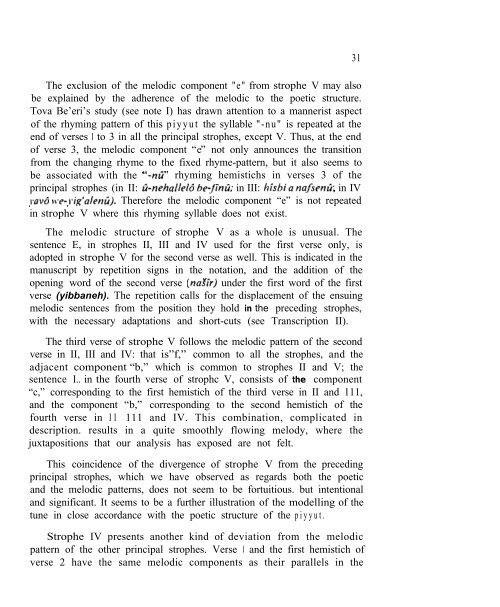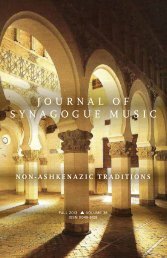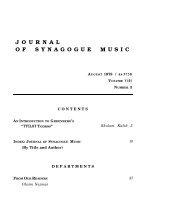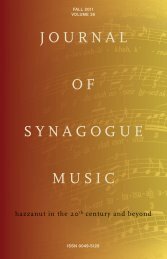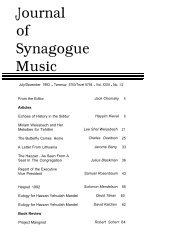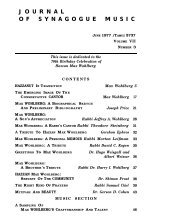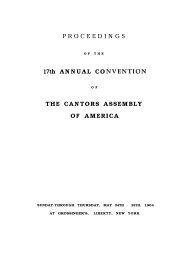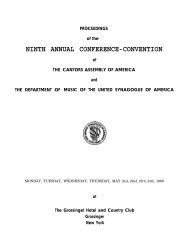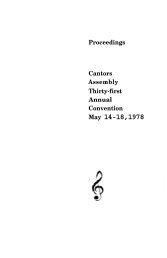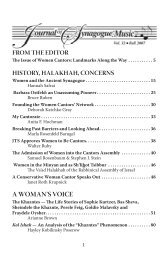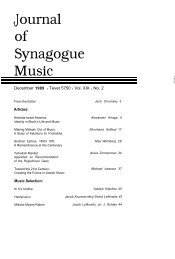Volume 16, Number 2 - Cantors Assembly
Volume 16, Number 2 - Cantors Assembly
Volume 16, Number 2 - Cantors Assembly
You also want an ePaper? Increase the reach of your titles
YUMPU automatically turns print PDFs into web optimized ePapers that Google loves.
The exclusion of the melodic component "e" from strophe V may also<br />
be explained by the adherence of the melodic to the poetic structure.<br />
Tova Be’eri’s study (see note I) has drawn attention to a mannerist aspect<br />
of the rhyming pattern of this piyyut the syllable "-nu" is repeated at the<br />
end of verses I to 3 in all the principal strophes, except V. Thus, at the end<br />
of verse 3, the melodic component “e” not only announces the transition<br />
from the changing rhyme to the fixed rhyme-pattern, but it also seems to<br />
be associated with the "-nu5 rhyming hemistichs in verses 3 of the<br />
principal strophes (in II: ti-nehalleld he$nti; in III: hisbianqfienti; in IV<br />
,rav6 rc’e-_i*ig’:)alerrfi). Therefore the melodic component “e” is not repeated<br />
in strophe V where this rhyming syllable does not exist.<br />
The melodic structure of strophe V as a whole is unusual. The<br />
sentence E, in strophes II, III and IV used for the first verse only, is<br />
adopted in strophe V for the second verse as well. This is indicated in the<br />
manuscript by repetition signs in the notation, and the addition of the<br />
opening word of the second verse (na&+j under the first word of the first<br />
verse (yibbaneh). The repetition calls for the displacement of the ensuing<br />
melodic sentences from the position they hold in the preceding strophes,<br />
with the necessary adaptations and short-cuts (see Transcription II).<br />
The third verse of strophe V follows the melodic pattern of the second<br />
verse in II, III and IV: that is”f,” common to all the strophes, and the<br />
adjacent component “b,” which is common to strophes II and V; the<br />
sentence I.. in the fourth verse of strophc V, consists of the component<br />
“c,” corresponding to the first hemistich of the third verse in II and 111,<br />
and the component “b,” corresponding to the second hemistich of the<br />
fourth verse in I I 111 and IV. This combination, complicated in<br />
description. results in a quite smoothly flowing melody, where the<br />
juxtapositions that our analysis has exposed are not felt.<br />
This coincidence of the divergence of strophe V from the preceding<br />
principal strophes, which we have observed as regards both the poetic<br />
and the melodic patterns, does not seem to be fortuitious. but intentional<br />
and significant. It seems to be a further illustration of the modelling of the<br />
tune in close accordance with the poetic structure of the piyyut.<br />
Strophe IV presents another kind of deviation from the melodic<br />
pattern of the other principal strophes. Verse I and the first hemistich of<br />
verse 2 have the same melodic components as their parallels in the<br />
31


